Legendary binoculars - Leitz Amplivid 6x24
1. Leitz Amplivid 6x24 - 1956-1962
The history of prismatic binoculars started in 1893, when Ernst Abbe, working for the Carl Zeiss company, used an especially translucent kind of borosilicate glass, delivered by Schott, to create a system of two prisms which not only inverted images but also were able to employ the total internal reflection phenomenon. Abbe wasn’t aware of the fact that the same image inversion system was discovered and patented by an Italian optics specialist, Ignazio Porro, several dozen years earlier. Of course that fact doesn’t diminish the success and achievements of Abbe and Zeiss – they still remain the first producer of a pair of binoculars with Porro prisms.
What’s interesting, the first set of binoculars based on roof prisms was presented not much later, already in 1898, by Moritz Carl Hensoldt but it is quite another story.
Please Support UsIf you enjoy our reviews and articles, and you want us to continue our work please, support our website by donating through PayPal. The funds are going to be used for paying our editorial team, renting servers, and equipping our testing studio; only that way we will be able to continue providing you interesting content for free. |
- - - - - - - - - - - - - - - - - - - - - - - - - - - - - - - - - - - - - - - - - - - - - - - -
The success of Zeiss inspired other optics producers. The German company called Leitz launched their first binoculars in 1907. One part of their production consisted of simple Galilean constructions but you could also find in their line-up the prismatic Binocle 6x18 model and, in 1908, the Binodal 6x21. The list of products was getting longer and longer; promotional catalogues from 1909 feature already prismatic binoculars with the 8x magnification ratio.
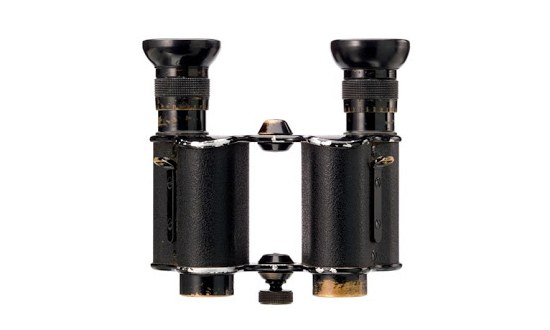 Leitz Binocle 6x18 from 1907. |
During next 50 years Leitz launched several dozen Porro prism models, among them such classic devices as the Binuxit 8x30, the Marseptit 7x50, the Camparit 10x40 or the Mardocit 12x60. The diversity was great: along smaller theater or opera binoculars, employing the inverted Porro system, such as the Binar 3x13.5 and the Oberon 3.2x13.8, you could find such huge instruments as the Binoplastico 27x90.
In the 50s of the 20th century Leitz decided to leave Porro prism constructions behind and launch something quite different. It all started with a patent of Maximilian Ludewig who suggested a new image inversion system based on two mirrors and a pentagonal prism. A drawing of that system, taken from the original patent application, is shown below.
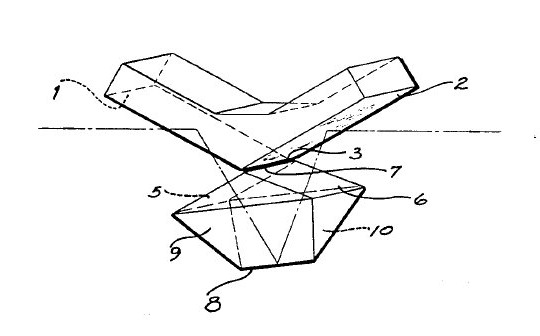 Image inversion system from the patent application of the Leitz GMBH company. |
The next drawing shows the same inversion system set inside the binoculars – it was taken from another Leitz GMBH patent application, concerning central and internal focusing system which was featured in the Trinovid series.
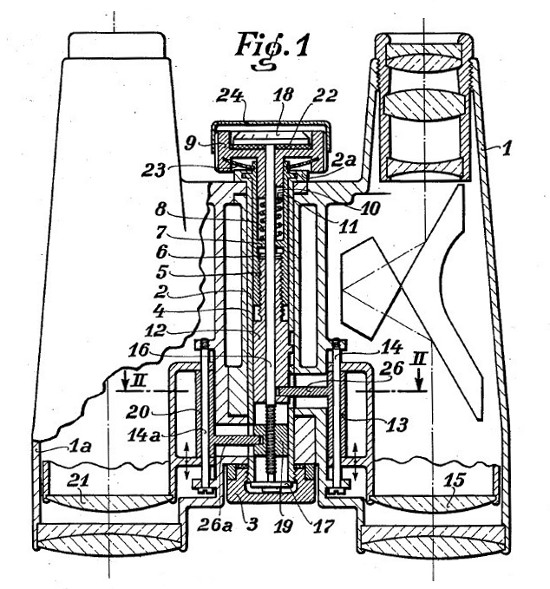 A diagram taken from one of Leitz GMBH patent applications. It’s worth mentioning that in fact such a pair of binoculars was never produced. The diagram is showing a combination of Amplivid inversion system with the Trinovid body; the Trinovid, though, featured an inversion system based on the Uppendahl prism design. |
Of course an inversion system is not all – the Leitz company complemented it with an achromatic objective lens and a wide angle eyepiece, also designed by Max Ludewig. The Leitz Amplivid 6x24, with an impressive field of view of 12.1 degrees (212 meters by 1000 meters) was the final result of such a combination. What’s more, that pair of binoculars was really small and handy – it weighed just 356 grams, being 11 cm long and 11 cm wide.
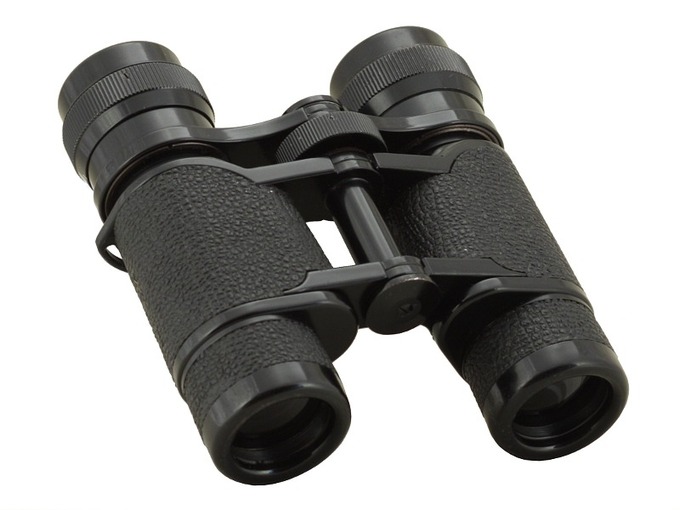 Leitz Amplivid 6x24 |
Of course that instrument had also some flaws. In those times the mirrors were coated by aluminum which reflected about 90% of light. Two mirrors in the inverted system gave you over 20% of light loss; add to that the loss on prism and air-to-glass surfaces in the objective and the eyepiece. Taking into account the fact that in the 50s there were only simple, single antireflection coatings available, the effective transmission of the whole instrument reached only near 60%.
By the way the transmission of the Amplivid 6x24 doesn’t have to be an object of a debate because we measured it using a professional spectrophotometer. An appropriate graph is presented below.
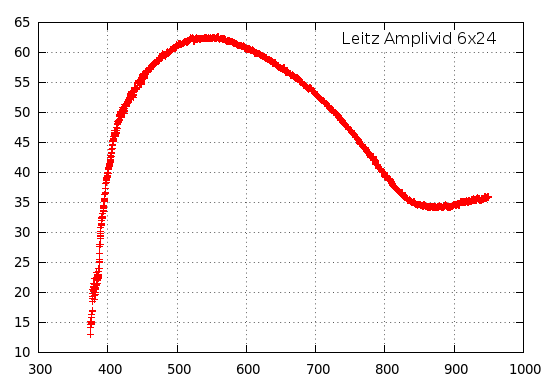 The dependence between transmission [%] and wavelength [nm] for Leitz Amplivid 6x24. |
It is clear that the peak of its possibilities, amounting to 62%, the binoculars reach in the visible spectrum centre (near 540 nm). Then the transmission level decreases, both at the shorter and the longer end of the spectrum. It explains a slightly yellowish hue of images you get looking through the Amplivid.
The huge field of view had its price too – its edge wasn’t corrected properly, featuring a lot of blurry areas, high levels of coma and chromatic aberration. What’s interesting, though, the distortion didn’t make itself felt. You also had to tolerate a not especially comfortable eye relief, amounting to 11-12 mm.
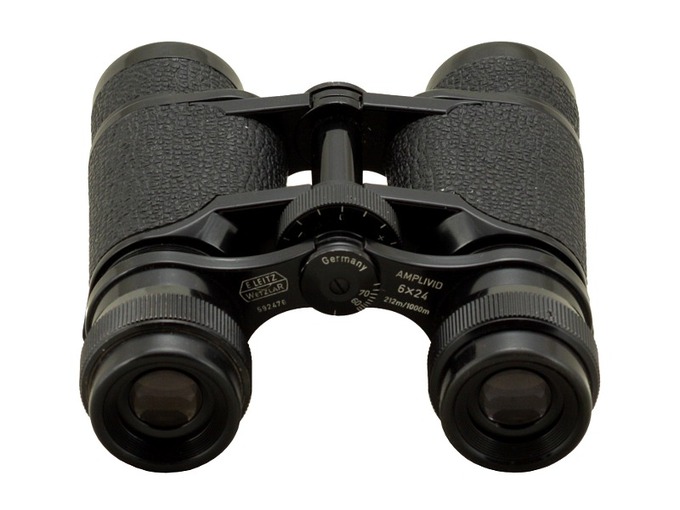 Leitz Amplivid 6x24 |
Despite those flaw the binoculars make a positive impression on anybody who takes it into their hands even today (or maybe especially today, when there are virtually no instruments with such big fields of view on the market). My wife was enchanted by the dimensions of the Amplivid, its image quality and the field of view. She didn’t want to part with it at all and was very surprised when she found out that an instrument with such parameters is only available on the second-hand market. Personally I am also sure that even nowadays the binoculars would have a lot of potential buyers. It would be a perfect instrument for children – the combination of 6x magnification with the huge field of view makes it especially comfortable to point at an object and keep it within the field.
You should add that a contemporary Amplivid wouldn’t have to have any transmission problems – modern dielectric coatings reflect over 99% of light so the loss in an reversible system can be limited to small several percent. Overall the whole instrument wouldn’t have any problems with letting about 90% of light through.
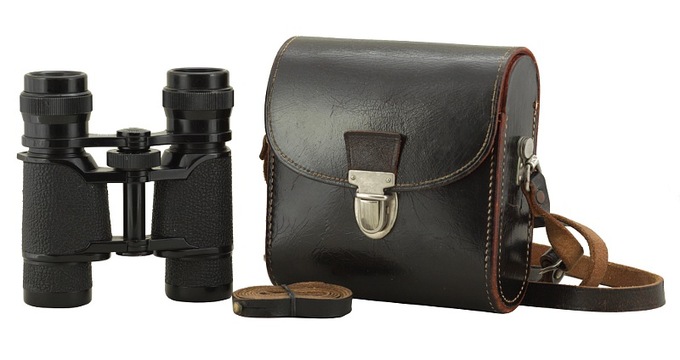 Leitz Amplivid 6x24 with neckstrap and case. |
The launch of the Amplivid was the first indication that the Porro binoculars would be disappearing from the Leitz line-up. The Amplivid was produced for six years only – not because the lack of popularity but because in 1958 two new binoculars called Trinovid, the 7x42 and the 8x40, were introduced. The Trinovids’ fields of view amounted to 70 and 80 degrees respectively; contrary to the Amplivid, they didn’t feature any ocular bridge but a fully-fledged inner focusing mechanism. In 1963, right after ending the Amplivid 6x24 production, the Leitz company launched its direct successor, the Trinovid 6x24, with the same field of view – a device definitely worth another ‘legendary binoculars’ article.
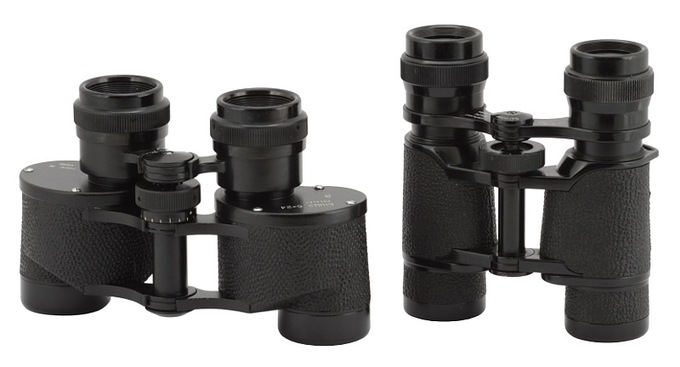 Leitz Amplivid 6x24 and its Russian competitor KOMZ 6x24. |
The Leitz Amplivid 6x24 can still be found on different internet auction sites. However, the small production volume means you still have to pay a lot for specimens in good working conditions – about 500 Euro is a steep price for such a small pair of binoculars. Despite that fact there is no lack of buyers; it shows that perhaps launching an instrument with similar parameters, of course fulfilling the contemporary requirements concerning the optics and coatings quality, would be a gamble worth taking. Anyone interested?
Personally I don’t doubt that the Leitz Amplivid 6x24 is one of the most interesting pairs of binoculars in my private collection. I always enjoy taking it out of its case and admiring its huge field of view.






